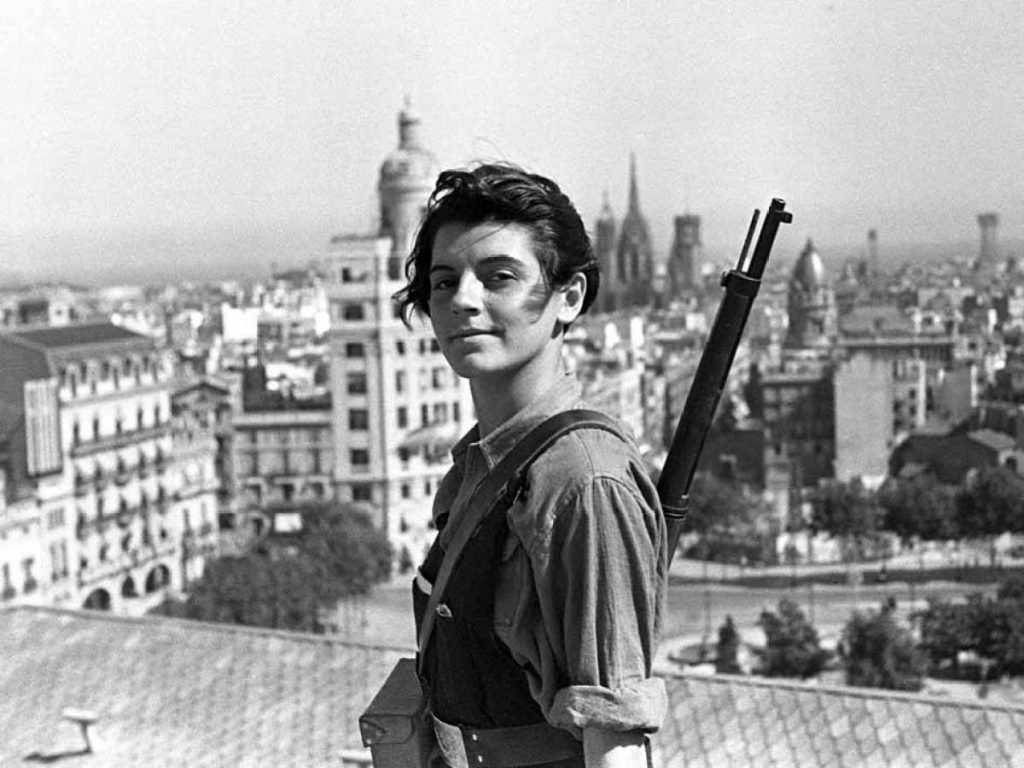
Marina Ginestà at the top of Hotel Colón in Barcelona, 21 July 1936. Photograph by Hans Gutmann. Copyright Juan Guzman (photographer), used under fair use terms of U.S. copyright law, and obtained from Wikimedia.
In July 1936, a young woman stood on the roof of the Placa de Catalunya hotel in Barcelona, Spain. She was just 17, yet the rifle she carried and the defiantly optimistic look on her face would ensure her name went down in history.
The young woman was Marina Ginestà. She was born in Toulouse, France, to a working class family, and moved to Spain at the age of 11. Sometime in the next six years, she joined the Unified Socialist Party, a communist political party that wanted to defend the middle classes against land seizures. When civil war broke out in Spain, Marina served as a reporter and translator for Mikhail Koltsov, a correspondent for the Soviet paper Pravda.
This photo, likely part of her time with Mikhail, was published in a local paper. Dressed in military uniform with the wind in her hair, and armed with a rifle (the first and only time in her life, she later stated), Marina was witness to a historic moment, and instantly became a symbol of the hopefulness of revolution. In a 2008 interview, she stated,
It’s a good photo. It reflects the feeling we had at that moment. Socialism had arrived, the hotel guests had left. There was euphoria. We retired in Columbus, we ate well, as if bourgeois life belonged to us and we would have changed category quickly.
The photograph quickly became a symbol of the conflict and anti-fascist resistance. It was a piece of propaganda at a time of rapid social and political change, but it was also a symbol of hope. Hope for a better future, for herself and her comrades. Hope that the rising tide of fascism would be stopped.
It was one moment of glory before the storm. Marina was wounded before the end of the Spanish Civil War and evacuated to France, which was occupied by the Nazis. She soon fled her homeland, immigrating to the Dominican Republic and escaping the horrors of war in Europe. Within ten years, though, her peace was interrupted again by the rise of dictator Rafael Trujillo. She fled and returned to Europe, eventually marrying a Belgian diplomat and finally returning to Barcelona in 1952. Marina moved to Paris in the 1970s, where she died in January 2014 at the age of 94.
Was her life filled with moments of glory and hope like this one? Or was this rooftop in Barcelona the last place to bear witness to her youthful optimism?
We may never really know.
-Tiffany Rhoades
Program Developer
Girl Museum Inc.
This post is part of our 52 Objects in the History of Girlhood exhibition. Each week during 2017, we explore a historical object and its relation to girls’ history. Stay tuned to discover the incredible history of girls, and be sure to visit the complete exhibition to discover the integral role girls have played since the dawn of time.
